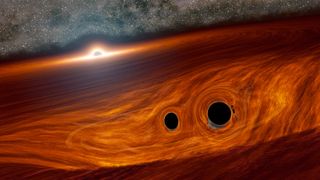Scientists spot flash of light from colliding black holes. But how?

An artist's depiction of two black holes merging within the disk of a supermassive black hole, later releasing a burst of light.
(Image: © Caltech/R. Hurt (IPAC))
Black holes aren't supposed to make flashes of light. It's right there in the name: black holes.
Even when they slam into each other, the massive objects are supposed to be invisible to astronomers' traditional instruments. But when scientists detected a black hole collision last year, they also spotted a weird flash from the crash.
On May 21, 2019, Earth's gravitational wave detectors caught the signal of a pair of massive objects colliding, sending ripples cascading through spacetime. Later, an observatory called the Zwicky Transient Facility (ZTF) caught a blast of light. As scientists looked at the two signals, they realized both came from the same patch of sky, and researchers started wondering whether they had spotted the rare visible black hole collision.
No comments:
Post a Comment